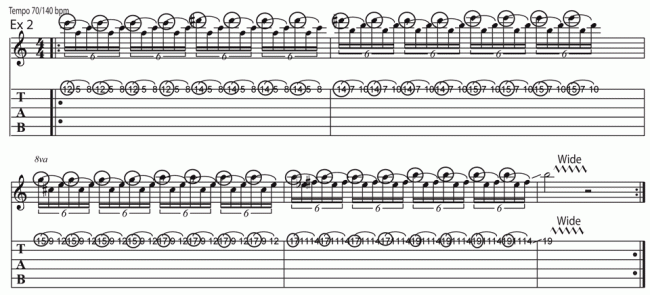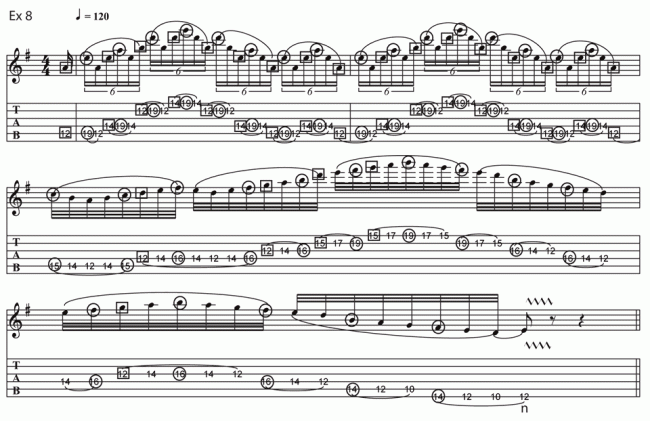
WARNING: Hammer-ons and pull-offs can kill! Warm up and take frequent shake-off breaks. Try to pull outwards and downwards away from the string lightly so you can hear the resonance of the pull-off.
Ex 1: Here we have the ½ roll tapping technique that stunned the world in 1978! The example is a single string A minor triad with the root note on the index finger, the b3rd played using the 4th finger, and the 5th degree is tapped at the 12th fret. The main consideration of the technique is clean and timely execution and you will need to be aware of the interplay between fretting and picking (tapping) hand muting techniques. Follow the rule that the fretting hand index always mutes the string above the one being played. In this case we will be on the high E string, so mute the B string above, all remaining strings are then muted off with the tapping hand as the thumb pad/heel of the hand rests gently on the strings. Hold the pick as usual and use the second finger to tap firmly. I would advise that you pull off from the tap downwards and outwards and try to get all notes equal in power and velocity to achieve the smoothest tone. Pulling off in an upwards direction is also common, so try both if you are new to the technique.
Audio clip: Adobe Flash Player (version 9 or above) is required to play this audio clip. Download the latest version here. You also need to have JavaScript enabled in your browser.
Ex 2: Here we have an A minor triad with the 6th as a melody note in bar 1, moving into bar 2 with a B minor triad on beats 1 and 2 and a G major triad on beats 3 and 4. Then in bar 3 we see a G diminished triad in beats 1 and 2, followed in beats 3 and 4 with an A major triad, finishing in bar 4 with an A diminished triad resolving to a B major triad. This example ends like a lick with an “Exit” or finishing note. This is the key to integrating the technique into other areas of your vocabulary. This particular “Third Finger Slide Exit” is one of several common in EVH’s playing. I would advise that the fourth finger is used up to the very last tap, and then quickly swap to the third for the slide and wide vibrato.
Audio clip: Adobe Flash Player (version 9 or above) is required to play this audio clip. Download the latest version here. You also need to have JavaScript enabled in your browser.
Ex 3: This next example is a rapid fire lick in E minor, and can be viewed within the territory of the Minor Pentatonic scale, with the 9th on the B string Tap added as a colour note and in order to keep the lick symmetrical. The examples demonstrates a method commonly used by EVH to exit from ½ roll Tapping licks, the “Reverse pattern to Bend” exit or finishing note, which effectively turns the lick around and allows for an easier landing on the final note which is then immediately bent from the b7 up to the Root note, ending on tone-wide/ push-upwards rock vibrato.
Audio clip: Adobe Flash Player (version 9 or above) is required to play this audio clip. Download the latest version here. You also need to have JavaScript enabled in your browser.
Ex 4a, b, c : Here we have the three main full-roll repetition fragments in A Dorian, starting in the first position caged area at the 5th fret. On the first exercise, fingers 1, 3 and 4 are used on the fretting hand. On the second, fingers 1, 2 and 4 are used and on the third, fingers 1,2 and 4 are used. Try to keep all the notes even in velocity, aiming for a smooth and fluid tone. The pick which starts the exercise off, is written in a bracket to indicate that there is no re-pick on the repetition. Try to keep the exercise repeating continuously and always shake off when any tension occurs. The pick will play the first note over the fretboard near to where the tap is executed and will then rest, muting the lower strings in that position, there is no need to bring the picking hand back to the conventional bridge position. On the audio example, these initial fragments are played at a “learn speed” of triplets at 70bpm, followed by an intermediate speed of sextuplets at 70bpm, finishing with a top standard speed of sextuplets at 140bpm.
Audio clip: Adobe Flash Player (version 9 or above) is required to play this audio clip. Download the latest version here. You also need to have JavaScript enabled in your browser.
Ex 5: This next example develops our 2 string fragment over three strings starting in position 1 A Dorian. Both bars can be isolated at first and are very good static repetition exercises in their own right. Once the descending and ascending patterns have been memorised, join them together to form the whole example. The phrase ends on the b7, with tone wide, push upwards rock vibrato. As with this technique in general, the timing and tone are the most important factors, no speed can occur or be of any quality unless timing and tone through accuracy are firmly in place, so practice slowly and build speed on a gradual basis, often staying at a certain speeds for weeks especially as you get to the faster tempos.
Audio clip: Adobe Flash Player (version 9 or above) is required to play this audio clip. Download the latest version here. You also need to have JavaScript enabled in your browser.
Ex 6: Here we have an example in the style rock virtuoso Reb Beach(Winger/Dokken/Whitesnake). As we are fairly high up in position 5 (3-notes-per string) or starting in position 4 from a caged point of view around the R5th A minor chord, it is common to see rock players use fingers 1, 2 and 3 on the fretting hand for this particular shape and this also lends more of an angle to the hand which in turn sets up a good position for the “exit” or finishing phrase. The traditional classically based “correct” fingering of 1,2 and 4 should also be developed as you will see both commonly used in different circumstances. Regardless of the fingerings used, I would advise that the exit phrase uses the 3rd finger for the fretting hand Tap (or hammer-on from nowhere), setting the hand up at an angle for the final bend on the b7. Once the lick is played, visualise yourself in the high position 1, A minor Pentatonic scale and continue improvising. This way you will start to integrate these new licks in with your present vocabulary.
Audio clip: Adobe Flash Player (version 9 or above) is required to play this audio clip. Download the latest version here. You also need to have JavaScript enabled in your browser.
Ex 7: Here we have an ascending D major scale, but as you’ll hear an E minor pad on the audio CD, we will be viewing the E note as the root. This means we are looking at our D major scale from the perspective of its second mode, E Dorian, therefore the first note of our scale shape will be viewed as the b7. Anytime you are playing over a minor chord, simply move back a whole step and play the major scale shape and you will access the Dorian sound starting on the b7. As you play through slowly at first, try to be aware of any string noise, with all notes equal in velocity. When ascending, the first note on each string is hammered down with the fretting hand index finger, on the descent in bar 2, the right hand Tap leads the pattern across the strings.
Audio clip: Adobe Flash Player (version 9 or above) is required to play this audio clip. Download the latest version here. You also need to have JavaScript enabled in your browser.
Ex 8: Here we have an unusual sounding idea which uses 5ths to create a colourful, intervallic sound, followed by a fast left and right handed scalar passage in A Dorian (R 2 b3 4 5 6 b7). Again, try to pay particular attention to the muting of un-played strings so as to keep it clean. Learn the lick in small sections at a very slow speed until memorised before applying speed. The fretting hand index generally will be weak unless you are already familiar with this approach, and much time in the early stages of development will be focussed on the strength, accuracy and muting using this all important finger.
Audio clip: Adobe Flash Player (version 9 or above) is required to play this audio clip. Download the latest version here. You also need to have JavaScript enabled in your browser.
Ex 9: This first example is an ascending and descending roll through an A Minor 7 (R b3 5 b7) arpeggio in position 4 of the Caged system (visualise the position 4 “A” shape barre chord for Am). All these arpeggios should be visualised around the corresponding Caged minor chords. Hammer down the first note with the fretting hand index finger from a height, and practice landing so as to mute the string above with the index tip, and all underneath. Fingering wise I would advise fingers 1 and 4 for three fret (minor 3rd) stretches and 1 and 3 for the two fret (tone) spacing. Some players will also use fingers 1 and 3 throughout so there is room for experimentation. The thumb should be in the middle of the back of the neck with plenty of space around the guitar neck, the hand in a dropped position with the fingers fairly straight and square to the fretboard. Once the shape is memorised, practice slowly and continuously for 3-5 minutes, breaking only to shake off any accumulation of tension.
Audio clip: Adobe Flash Player (version 9 or above) is required to play this audio clip. Download the latest version here. You also need to have JavaScript enabled in your browser.
Ex 10: Here we have an example that utilises a sliding right hand tap on both the G and high E strings. Try to hit the Right Hand Tap hard and shift up and back from the arm, paying particular attention to the timing of the slides. The right hand thumb pad/ heel of the hand will still be effectively muting the lower bass-side strings and you will need to rest on the strings very lightly so as to minimise the sound of the right hand mute as it shifts. The “exit” or finish note is a pull-off from the previous Right Hand Tap. To get the most aggressive tone for the exit, try to pull the Tap off quite hard and follow up with tone-wide “pull-downwards” rock vibrato. Once the exit has been hit, move the picking hand very quickly back to the pick-up area and lock all the strings above the exit note by lodging the pick up into the string above and bringing the thumb in to deaden the un-played lower strings. This lick is demonstrated on the GT CD at “learn” speed, followed by a standard top sixteenth note speed and then as fast as is possible using feel to target the exit on the nearest beat. This is the more common approach in improvisational modern rock. Written solos tend to lean more towards strict sub-divisional lines.
Audio clip: Adobe Flash Player (version 9 or above) is required to play this audio clip. Download the latest version here. You also need to have JavaScript enabled in your browser.
Ex 11: Here we have a 4-notes-per string, string skipped Pentatonic example, with slides on the high E string. It is worth isolating the string where the slides are and making up a separate repetition fragment to hone in on the timing. Try to maintain the pressure on the tapped note as it slides back and forth or it may die away. The motion of the slide may feel fairly jerky and robotic at slow tempo to get the timing precise and moves from the elbow pulling back slightly. Meanwhile the fleshy part of the thumb pad on the right hand, rests lightly on any lower, unattended strings so as to mute.
Audio clip: Adobe Flash Player (version 9 or above) is required to play this audio clip. Download the latest version here. You also need to have JavaScript enabled in your browser.
Ex 12: Here we have a lick that features a sliding Right Hand Tapped note as well as a fretting hand index finger slide on the G string, which takes us from position 4 Am Pentatonic up into position 5. With all the sliding going on, be careful to mute the string above the one being played and all underneath by setting the index finger fairly flat. When you are playing the high E string, the right hand thumb pad/ heel of the hand mutes the lower strings. The lick finishes on the root note with a downstroke, followed by push upwards tone wide rock vibrato.
Audio clip: Adobe Flash Player (version 9 or above) is required to play this audio clip. Download the latest version here. You also need to have JavaScript enabled in your browser.














